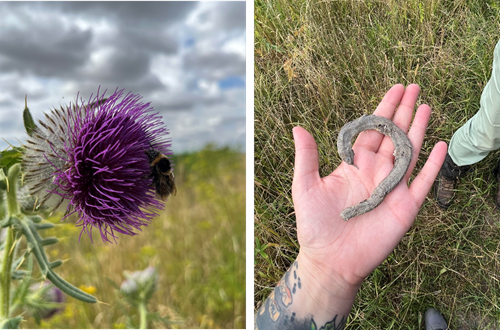Summer is studying Animal Behaviour and Wildlife Conservation and has joined the Lowland Gamebird Research team on placement.
The first week of my placement with the GWCT has been such a brilliant experience. I’ve learned so much already, although I do feel like I’ve been given so much information that I haven’t taken it all in just yet!
To start off the week, we spent a day in the office reading about all the research the GWCT carries out. It’s great to see the wide variety of research that is done here to contribute to the conservation of the wildlife in the countryside. In particular, I found it interesting to read about how the culling of foxes helps to protect prey species that are otherwise vulnerable to predation by foxes.
We carried out fieldwork from Tuesday to Thursday, which involved walking transects around two different sites each day and collecting fox scats that were found along each of the transects. We were also required to observe the wildlife present on the sites as we walked the transects, including deer, hares, buzzards and red kites. I really enjoyed getting to see a red kite (Milvus milvus) in person and learning how to distinguish it from other birds of prey (they have forked tails), as I don’t often see many birds other than pigeons back home!
Although the aim of the fieldwork is to collect fox scats, I was also able to enjoy the surrounding countryside and wildlife at the same time. I loved seeing all the vibrant vegetation, and the bees and butterflies that were resting on them. It was also very exciting to come across a slow worm (Anguis fragilis) whilst walking one of our transects, although I do wish it had been a live one!

Figure 1 White-tailed Bumblebee (Bombus lucorum); Figure 2 Dead Slow Worm (Anguis fragilis)
Whilst walking the transects has been tiring, especially on the warmer days, and collecting 63 fox scats from a single site definitely proved to be a challenge, the breath-taking views of the countryside and the variety of wildlife I have been able to see this week really does make all of that walking worth it!

Figure 3 The view of the countryside from a transect walk
Over the next few months, I am hoping to investigate the diet of owls in the area by examining owl pellets to see what kind of things the owls have been eating. I am interested to learn whether improving conditions for species that the owls prey upon, such as small mammals, would also aid in the conservation of owls locally.
Whilst walking one of our transects on Tuesday, we found an owl pellet near to the edge of the crop - it could have easily been mistaken for a fox scat! Within the pellet there was the skull of a small mammal, likely a mouse, and some other smaller bones. This piqued my interest, and I am hoping to gain an understanding of the food types owls prefer by identifying the bones found in the pellets. I would also like to gain some experience in using GIS to help with data analysis so that I can incorporate the use of that into my final year research project when I return to university.
My first week has been extremely enjoyable, and I am looking forward to spending my placement year gaining new skills and learning about all the various research being carried out by the different departments within the GWCT!